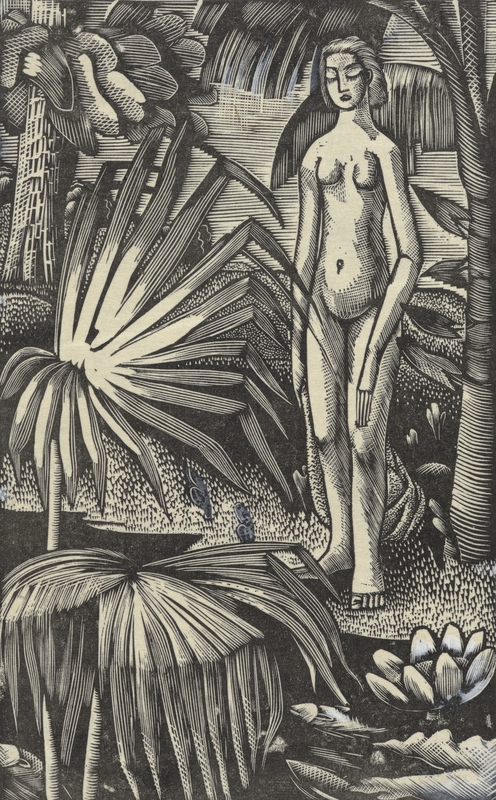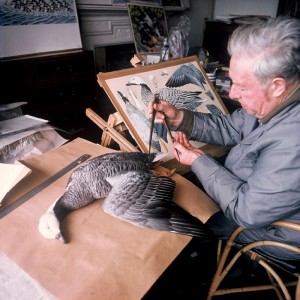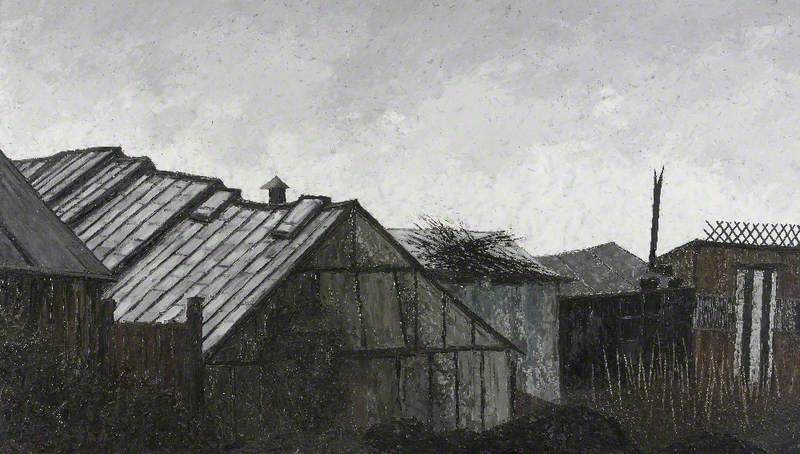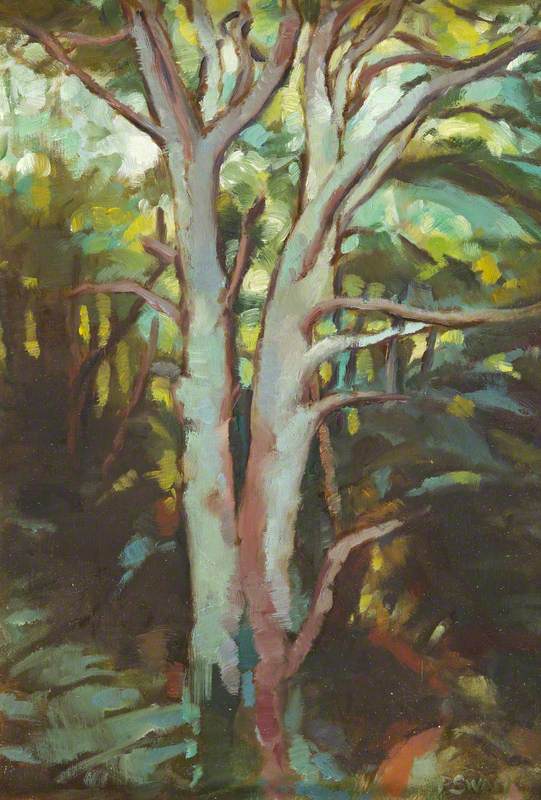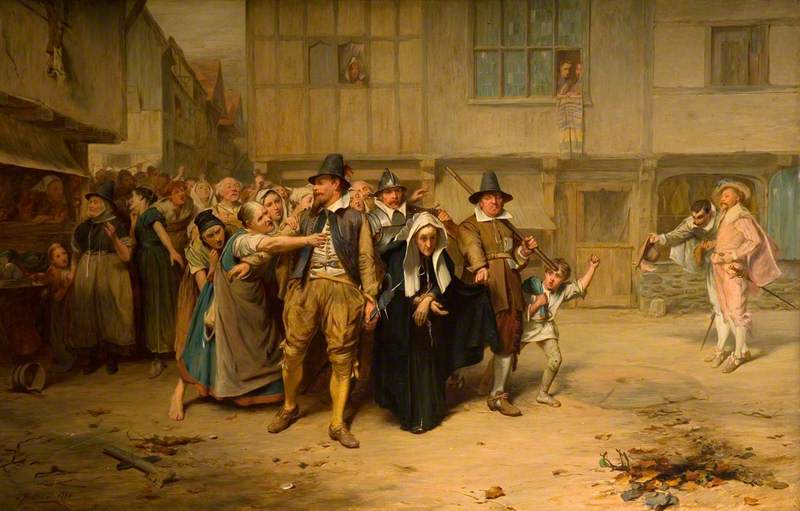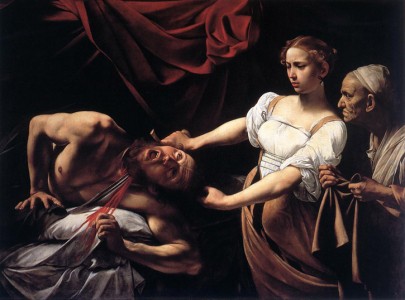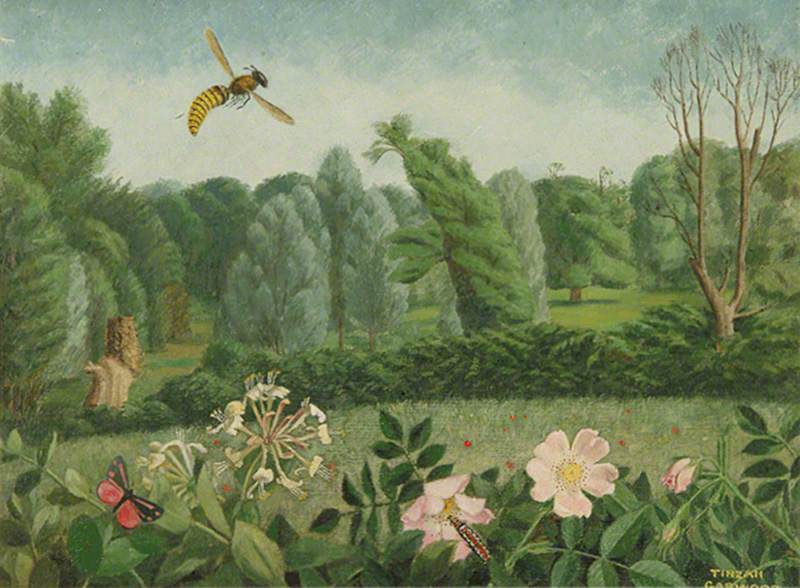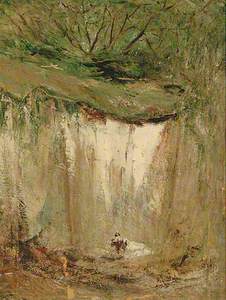'Art, Life and Us', the current exhibition at Towner, is the first to be guest-curated by artists. The gallery has invited the sisters Christine and Jennifer Binnie to select around 50 works, building a show from the permanent collection. Looking primarily at the natural world and the body, 'Art, Life and Us' also marks a homecoming of sorts for the pair.
Sexist Crabs Performance, Portland Bill Sculpture Park
1984, photograph by Christine Binnie and Jennifer Binnie 
After they moved from Hampton Wick, London to Wannock, Eastbourne in the 1960s, the rural landscape of East Sussex played an important role in the formation of the artists' identity and cultural development. They both attended Eastbourne College of Art and Design, and as Christine asserts in the exhibition guide, 'After Eastbourne Art College … we lived our lives as art.'
Examples from their own radical and exuberant artistic output have been interwoven throughout the gallery, notably Christine's decorated earthenware pottery and Jennifer's oil and gouache paintings. Numerous watercolour paintings of trees and landscapes by their father, Kenneth Binnie, have also been included. Despite having their own independent practices, Christine and Jennifer have collaborated throughout much of their lives.
Neo Naturist: Christine Binnie body-painted at St Martin's School of Art
1980, photograph by Wilma Johnson 
In the 1980s, when living in London, the two of them formed the collective the Neo Naturists with their friend Wilma Johnson. Their live art performances, in which they were notorious for turning up at nightclubs adorned in nothing but body paint, intersected with squat culture and the New Romantic club scene.
A photograph in the exhibition from 1982, taken by Johnson in their studio at St Martin's School of Art, shows Christine with a face depicted in paint daubed with flourish over her naked skin: her breasts turned into eyes and a large smiling mouth spreading across her abdomen.
By contrast, a significant proportion of the show has been dedicated to representations of the South Downs as captured by Ethelbert White. These are impressions of the chalk pits by Canon Smythe, the Friston Forest by Robert Tavender, or snowy scenes of the local village Alciston by Frank Wootton.
In Wannock Weekend (1980), an early film made by the Neo Naturists and one in a series being shown on a loop in the exhibition, they are shown enjoying the pleasures of the bucolic landscape with an extended group of friends, including the artists Grayson Perry and Cerith Wyn Evans. In one scene, Christine simulates sex with 'The Long Man of Wilmington', a large hill figure carved into Windover Hill, on the northern slope of the South Downs. Neo Naturist performances often combined references to pastoral symbolism and pagan ritual to play with feminist sexuality issues, reviving the spirit of 1960s bodily liberation.
In a catalogue essay from 2002, the curator Andrew Wilson refers to this unique combination as 'English village fête practicality with Girl Guide common sense, hippie idealism, the spirit of love, a child-like innocence and amateurism, all in a post-punk context.'
The empowered female form was a key curatorial interest for the sisters when choosing works from the Towner’s collection. Christine writes, 'We chose as many nudes as possible to reflect the Neo Naturists.' The work of Harry Phelan Gibb, the British Modernist painter inspired by Fauvism and the European avant-garde, appealed to them due to the fact 'women are nearly always in groups rather than on their own…a feeling of nude female solidarity.'
The pastel-hued oil-on-canvas works, such as Rose Nudes in a Landscape and Rose Nudes (1913), particularly demonstrate this, with women and children shown peacefully bathing and reclining.
Drawings by Alfred Stevens and Paule Vézelay's drypoint etching Two Women (1927) also depict women in pairs. In the early 1920s, Vézelay spent her summers on the hedonistic French Riviera, and her work from that period often showed nude swimmers and sunbathers.
Occasionally, the representations of nude women are more ambivalent, and the decision to include Walter Richard Sickert's The Poet and His Muse (1907) caused debate between the two curators. For Jennifer, 'the woman is strong and holding her own in spite of being naked. She has her hand on the man and is standing while he sits, and so seems to me to be in a position of power.'
Whereas, for Christine, 'it reminds me of the unease felt when as a life model I found myself too close to a man. I can smell the sweaty tweed and feel its scratchiness.'
Another work in the show, Eric Ravilious' illustration Girl with Palms, was made for the dust jacket of Flower Phantoms by Ronald Fraser. In the book, the libidinal awakening of the female protagonist is inspired by her studies at Kew Gardens. The importance of the symbiotic connection between people and the natural landscape, although not necessarily in an erotic sense, was another consideration for the exhibition.
In relation to Edward Louis Lawrenson's The Last Sussex Team, Jennifer observes, 'this painting is so beautiful and poignant, speaking of a bygone age when people were closer to the earth and to animals.'
Frederick Goodall's oil painting Gypsy Encampment shows a romanticised view of a family living in a shelter in the fields, cooking on an open fire. Like the Sickert, Ilsa Rodmell's undated oil Chase (The Hunt) is another choice that is riddled with visual and theoretical contradictions.
'I like the naïve cheerful quality of it', writes Jennifer, 'the event creates a colourful pageant-style spectacle which must be exhilarating to participate in. However on the other hand, hunting is barbaric, cruel and an outdated activity. I can't understand how anyone can take pleasure in torturing and killing an animal.'
A series of intricate pencil drawings on paper by Elizabeth Paget Smith, found in the collection, were of particular intrigue to Christine and Jennifer, showing the area detailed 'through the eyes of a woman living more than a century ago'. This lineage between two local female artistic talents, living and working one hundred years apart, feels significant to the theme of the exhibition, celebrating the beauty and the cycle of life.
Philomena Epps, writer







